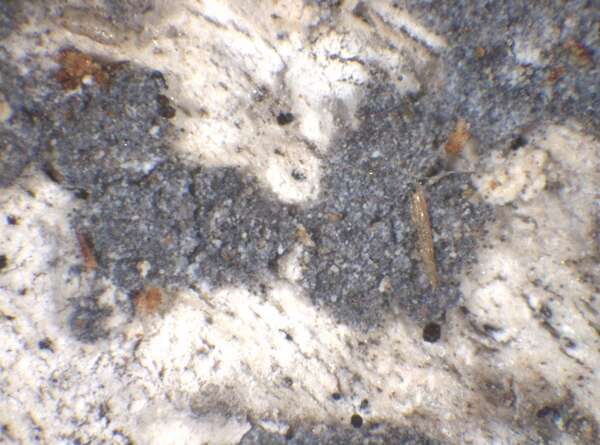Lecanographa amylacea (Pers.) Egea & Torrente (trebouxioid)
Bibl. Lichenol., 54: 122, 1994. Basionym: Lichen amylaceus Ehrh. ex Pers. - Plant. Crypt. Exsicc.: 303, 1793.
Synonyms: Buellia violaceofusca G. Thor & Muhr
Distribution:
Description: This lichen appears in two very different morphotypes, depending on the photobiont, this description refers to the form with a trebouxioid photobiont: Thallus crustose, endosubstratic or episubstratic and then granular, up to 0.15 mm thick, pale grey to almost white, with scattered, maculiform, 0.15-0.6 mm wide, often confluent soralia which are dark dirty brown with a violet tinge, (greenish when abraded), the soredia 15-20(-23) µm wide, with brown, 1.8-2.5 µm thick outer hyphae, the inner colourless hyphae 1.3-1.7(-2) µm thick. Apothecia and pycnidia not known. Photobiont chlorococcoid. Spot tests: all negative, except the pigmented outer hyphae of the soredia, which react K+ greenish grey, N+ red-brown: medulla UV+ citrine-glaucous. Chemistry: without lichen substances. Note: a mild-temperate, mainly western lichen found on isolated, old deciduous trees with acid bark, especially oaks, on faces seldom wetted by rain. According to Ertz & al. (2018), the sorediate Buellia violaceofusca G. Thor & Muhr seems to be a trebouxioid photomorph of this species, the fungus, depending on the photobiont type, changing the morphology and the reproduction strategy. The trebouxioid morph, known from Scandinavia and Western-Central Europe, and the Eastern Alps (Austria), grows on the fissured bark of more or less isolated old deciduous tress (especially Quercus and Fraxinus), and should be looked for in Italy.
Growth form: Crustose
Substrata: bark
Photobiont: green algae other than Trentepohlia
Reproductive strategy: mainly asexual, by soredia, or soredia-like structures (e.g. blastidia)
Most common in areas with a humid-warm climate (e.g. most of Tyrrenian Italy)
In underhangs rarely wetted by rain

Predictive model


Felix Schumm - CC BY-SA 4.0
[VZR441], Austria. Voralbergia, Rätikon, Schruns, in monte Golmer
Joches, 2100 m. Ad truncum Fagi silvaticae vetustum. Leg. A. Vezda
& V. Wirth, 27.07.1986, dipl. det. G. Thor. EX A. VEZDA: LICHENES
RARIORES EXSICCATI NR. 441. As Buellia violaceofusca


Felix Schumm - CC BY-SA 4.0
[VZR441], Austria. Voralbergia, Rätikon, Schruns, in monte Golmer
Joches, 2100 m. Ad truncum Fagi silvaticae vetustum. Leg. A. Vezda
& V. Wirth, 27.07.1986, dipl. det. G. Thor. EX A. VEZDA: LICHENES
RARIORES EXSICCATI NR. 441. As Buellia violaceofusca
Growth form: Crustose
Substrata: bark
Photobiont: green algae other than Trentepohlia
Reproductive strategy: mainly asexual, by soredia, or soredia-like structures (e.g. blastidia)
Most common in areas with a humid-warm climate (e.g. most of Tyrrenian Italy)
In underhangs rarely wetted by rain

Predictive model


Felix Schumm - CC BY-SA 4.0
[VZR441], Austria. Voralbergia, Rätikon, Schruns, in monte Golmer Joches, 2100 m. Ad truncum Fagi silvaticae vetustum. Leg. A. Vezda & V. Wirth, 27.07.1986, dipl. det. G. Thor. EX A. VEZDA: LICHENES RARIORES EXSICCATI NR. 441. As Buellia violaceofusca


 INDEX FUNGORUM
INDEX FUNGORUM
 GBIF
GBIF
 DOLICHENS
DOLICHENS




